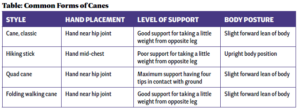
Figure 1
Post pictures of people using canes and doing fun activites in your waiting room.
Walking as good medicine is an ancient notion credited to Hippocrates.
Modern medicine continues to support walking as a means to a healthier life. The U.S. Department of Health & Human Services (HHS) advocates that adults participate in at least 150 minutes of moderate-intensity physical activity weekly. Walking is one way people can meet that goal. Previously, the HHS recommended engaging in 10-minute bursts of activity. However, the HHS now notes that even shorter periods of activity can be an effective way of meeting the 150-minute goal.1
Simple assistive devices, such as canes, can help people with impaired balance or joint pain stay active safely. However, some people may not understand how a cane can help them stay active or may resist using a cane for other reasons. After years of walking without assistive devices, regularly walking with a cane is a significant change. Patients may need our help to adopt this new behavior. We share several points to assist with patient-provider conversations to support the transition to walking with a cane.
Barriers to Cane Use
We humans are loss averse. We may emotionally or psychologically perceive a loss more intensely than we would experience a comparable gain. In other words, when we have something we value, we will work hard to not give it up, even when it may not be in our best interest. Some people may see using a cane as a loss of independence and youth, and it may be hard for them to see the gain of safety with mobility that a cane provides. Some people may give up walking rather than commit to using a cane.
Common perceptions about canes are barriers to their use. Canes are often viewed as indicators of frailty, old age and dependency. Because of these views, rather than being in public with a cane, some people may choose not to leave their homes. This decision may lead to a loss of independence as they become increasingly reliant on others to deliver their groceries and run their errands. Individuals may not recognize that a cane can promote independence, taking weight off a painful joint and assisting with balance issues while standing and walking.
Other barriers to cane use include uncertainty regarding how to select, obtain and use a cane, and low self-efficacy (i.e., confidence in one’s abilities).

